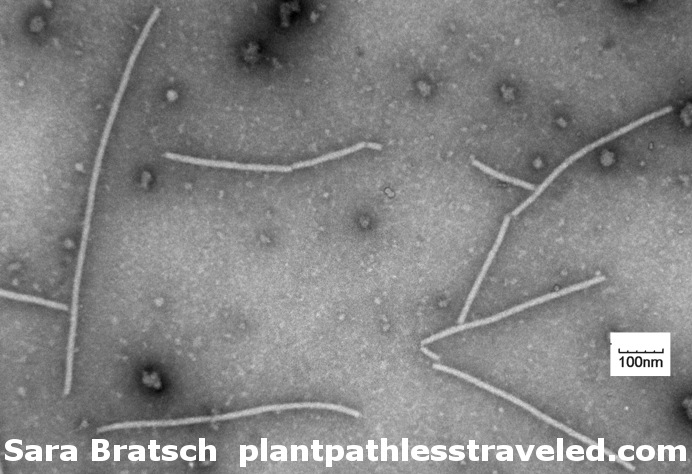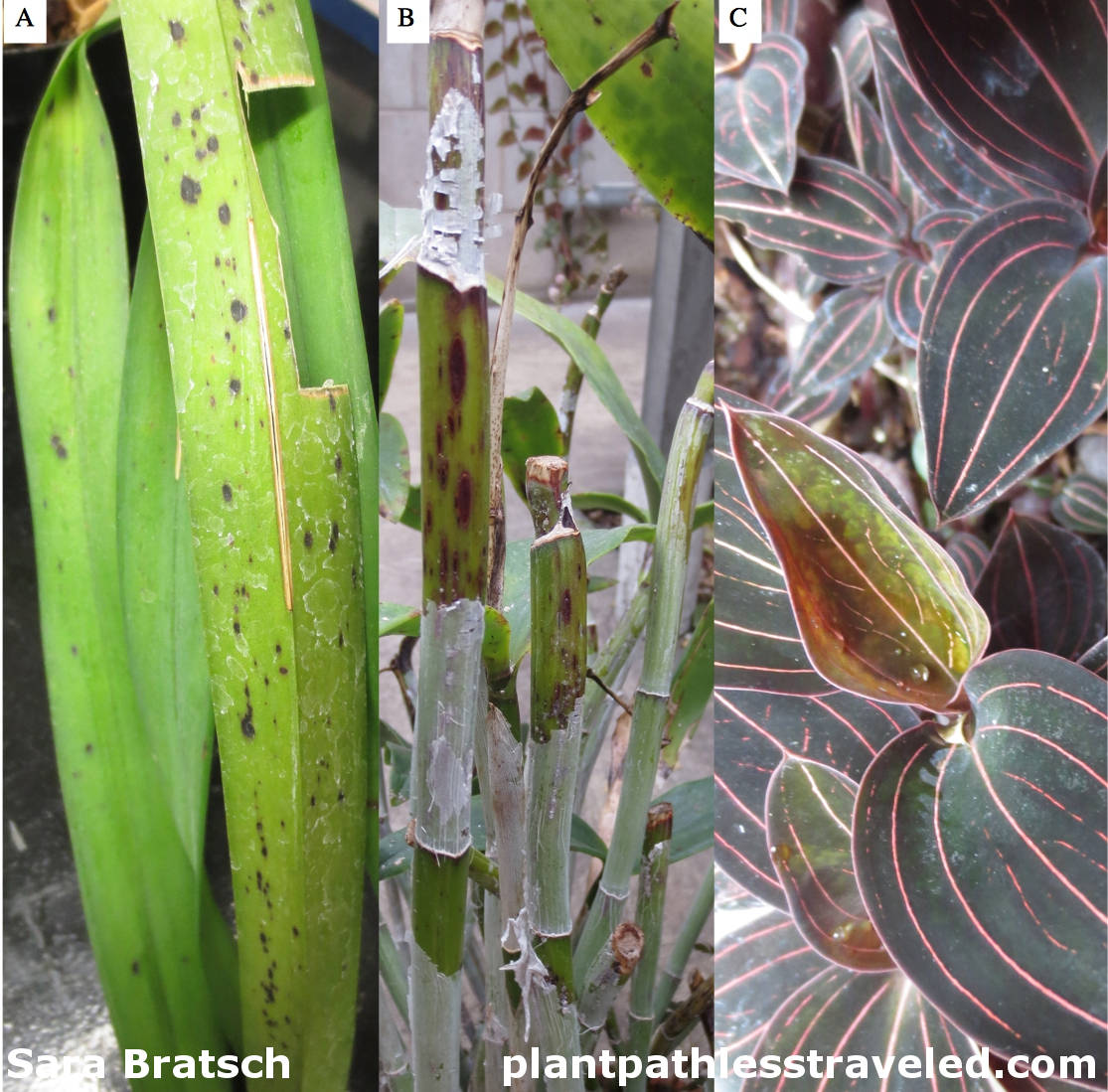Cymbidium Mosaic Virus
The orchid family is a diverse plant family that is globally traded. Orchids suffer from numerous pathogens including Cymbidium mosaic virus causing symptoms of necrotic spots, mosaics, or no symptoms at all. Purchasing only virus tested plants and sterilizing pruning tools will limit the risk of spreading this virus in your orchid collection.
Introduction
The orchid family is a diverse plant family valued for their exotic flowers, scents, and flavor. Orchids were first collected in the early 1800's by British explorers in South America and brought back to glass greenhouses in England. The ensuing "orchid fever" among hobbyists drove a lucrative business in procuring, rearing, and selling rare orchids collected from the wild. Small-scale production of orchids was common up until the 1950's when research studies revealed successful tissue culture protocols, planting media, environmental conditions, and fertilization methods to use for rapid Cattleya and Phalaenopsis production (Griesbach 2002).
Today the major countries producing orchids for potted plants or cut flowers include: China, Germany, Japan, Netherlands, Taiwan, and the USA. The USDA Floriculture Crops 2013 Summary shows that in the U.S. 170 businesses produced 30.3 million pots of orchids with a wholesale value of $246 million. In contrast to this in the cut flower orchid market 32 businesses produced 5.5 million stems of orchids with a wholesale value of $5.6 million.
As is often the case with plants that are globally traded and incredibly popular there are several pathogens that can damage or kill orchid plants. These include viruses (Cymbidium Mosaic Virus, Odontoglossum Ringspot Virus, Orchid Fleck Virus, others); bacteria causing soft rots and spots; and fungi causing wilts, root rots, and leaf spots. See Phelps Farms for more detailed pictures. (PDF file)
Virus details
Cymbidium mosaic virus (CymMV) was first described in 1951 and is also referred to as Cymbidium black streak virus, and Orchid Mosaic Virus (Jensen 1951). CymMV is a potexvirus with filamentous particles, 13 nm wide by 475 nm long, enclosing an RNA genome. CymMV and Odontoglossum Ringspot virus are the most common viral pathogens of orchids. CymMV and odontoglossum ringspot virus are the most common viral pathogens of orchids.
 Transmission electron microscope image of CymMV particles at 66,000 times magnification.
Transmission electron microscope image of CymMV particles at 66,000 times magnification.
Symptoms
CymMV causes brown necrotic spots on orchid leaves and flowers, but can also be symptomless. The major transmission method is mechanically through tools contaminated with virus infected plant sap or propogation by tissue culture of an infected mother plant. There are no known insect vectors and seed transmission is only likely at a very low rate or may not be possible. The possibility of seed transmission of CymMV has not been extensively studied.
Diagnostics
Testing methods for CymMV include indicator plants, reverse transcription polymerase chain reaction (RT-PCR), and antibody based methods including ELISA, immunosorbant transmission electron microscopy, and rapid antibody tests. The commercially available rapid antibody tests from Agdia for CymMV, which are available for orchid growers of all sizes, utilize a method similar to pregnancy tests with a band indicating a positive reaction from a sample of ground plant tissue. Plant Pathology diagnostic labs can also be consulted for orchid virus (and other pathogen) tests.
 Orchids infected with and showing symptoms of CymMV. Plants were tested by dipstick and ISEM. A. Vanda tricolor orchid showing older leaves with more brown streaks (right) and younger leaves behind (left) just beginning to show symptoms. B. Cattleya bicolor showing streaking symptoms on the canes and leaves. C. Ludisia discolor, jewel orchid, showing mosaic symptoms in the new growth. Due to the great genetic variation in the orchid family it is not wise to base a disease diagnosis on symptoms alone.
Orchids infected with and showing symptoms of CymMV. Plants were tested by dipstick and ISEM. A. Vanda tricolor orchid showing older leaves with more brown streaks (right) and younger leaves behind (left) just beginning to show symptoms. B. Cattleya bicolor showing streaking symptoms on the canes and leaves. C. Ludisia discolor, jewel orchid, showing mosaic symptoms in the new growth. Due to the great genetic variation in the orchid family it is not wise to base a disease diagnosis on symptoms alone.
Control
Control measures for CymMV include testing and isolating or destroying infected plants. Plants that will be used for mass propagation by tissue culture should be tested for viruses before they are used for propagation even if they do not show symptoms. Strict sterilization measures are necessary for all growth stages of orchids to prevent virus infections as CymMV can remain infectious in plant sap for up to a week at room temperature (Gibbs 1970). Tools should be single use like individual razor blades disposed after using on one plant, or thoroughly sterilized by dipping in ethanol and flaming for 15 seconds or dipping in 1% NaOH (bleach) between individual plants (Hu 1994). Skim milk does not inactivate CyMV and should not be used. NaOH concentrations higher than 1% inactivate CymMV but also cause phytotoxic damage on orchids (Hu 1994). It is important to sterilize repotting tools, pots, and benches as they can also serve as inoculation points for orchids.
It is important to choose virus-tested orchids when purchasing a new plant as that is the only way you can guarantee it does not contain a virus. Implementing sterilization techniques between your plants will limit the spread of any virus already in your collection.
All photos were taken by Sara Bratsch. For non commercial use only.
Please contact regarding all other uses.
Cite this article:
Bratsch, Sara. “Cymbidium mosaic virus”. 10 March 2015. http://plantpathlesstraveled.com/cymbidium-mosaic-virus/
Citations:
Gibbs, A.J.; Harrison, B.D.; Murant, A.F. (1970). CMI/AAB Descriptions of Plant Viruses. Commonwealth Mycological Institute, England. 27.
Griesbach, R.J. (2002). Development of Phalaenopsis Orchids for the Mass-Market. p. 458Ð465. In: J. Janick and A. Whipkey (eds.), Trends in new crops and new uses. ASHS Press, Alexandria, VA.
Hu, J. S., Ferreira, S., Xu, M. Q., Lu, M., Iha, M., Pflum, E., & Wang, M. (1994). Transmission, movement and inactivation of cymbidium mosaic and odontoglossum ringspot viruses. Plant disease, 78(6), 633-636.
Jensen DD (1951). Mosaic or black streak disease of Cymbidium orchids. Phytopathology 41: 401-414.